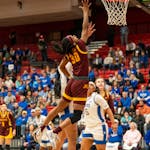 See
more of the story
See
more of the story
Ask Richard Pitino if he altered his coaching to achieve defensive improvement this season, and he'll joke that he went to a special class this summer. (He didn't.)
Then he'll suggest that becoming a better defensive coach required acquiring better defensive players. (He did.)
The most obvious difference between last year's enablers and this year's naysayers is center Reggie Lynch, who set the Gophers men's basketball single-season blocks record. His strength and ability to time his leaps have altered opponents' plans as well as their shots.
There is a more subtle reason for the team's defensive improvement, and his name is Amir Coffey.
Pitino was obligated to recruit Coffey. He was a great Minnesota high school player at Hopkins whose father played for the Gophers.
Instead of landing the next Kris Humphries, who any day now will be recording his first basketball assist, Pitino wound up with a versatile, selfless player who adapted surprisingly well to playing major-college defense.
With Lynch intimidating shooters near the basket and Coffey hurling his long frame and arms at shooters on the perimeter, the Gophers' defense has improved immeasurably.
And measurably.
Last year, the Gophers ranked 12th in defensive field-goal percentage and 13th in three-point defense in the Big Ten. They ranked ninth in blocked shots and defensive rebounds. None of their players finished in the top 20 in the conference in steals. Jordan Murphy and Bakary Konate finished tied for 13th in blocks.
This season, the Gophers finished first in the conference in defensive field-goal percentage, three-point-shooting defense and blocked shots. They finished first in defensive rebounds. Nate Mason tied for fifth and Coffey tied for 10th in steals.
Lynch led the conference in blocked shots, and Murphy finished fourth in defensive rebounds.
Mason improved defensively. Dupree McBrayer brought quickness and long arms. Akeem Springs added a strong body and a willingness to apply it to opponents. Freshman Eric Curry could become a star but this season has provided depth in the form of size and athletic ability.
Asked why his defense is better this year, Pitino said: "Length. Length on the perimeter. Amir is, I don't know, 6-7 or 6-8 and he can get to shooters. And then your [shooting guard] is Akeem, who has good length and long arms, and Dupree's got long arms, and then Murphy and Curry — it's got a lot to do with length.
"And I do think they're committed to defense. For a young team, they're really good with the scouting report. They care about it, they ask questions, which is kind of rare for young guys."
Pitino has frequently downplayed coaching adaptations when asked about the improvement of his defense. This week, speaking before he took the Gophers to Washington for the Big Ten tournament, he began answering that question with "No, not really."
Then he said this: "We've played less zone. That would maybe be the only X's and O's switch that we did. But it did help to have Reggie back there. He makes up for mistakes. Shot-blockers do that.
"Philosophically, we didn't change a whole lot. We've always been pretty committed to it. We don't press as much, and that's because we don't have a lot of depth in our backcourt. So maybe just changing from pressing and zone to a lot of half-court man."
When Pitino's defenses struggled the past couple of seasons, wise heads around the Big Ten would say, "He's never going to win until his teams can play good half-court man defense." Traps and presses look good during summer workouts and when surprising nonconference opponents. In the Big Ten, you need to be able to line up against good players and shut them down.
Lynch's arrival made the paint an unfriendly place, Coffey's arrival made the three-point line less welcoming, and suddenly Pitino arrived as a Big Ten coach.
Jim Souhan's podcast can be heard at MalePatternPodcasts.com. On Twitter: @SouhanStrib. • jsouhan@startribune.com



